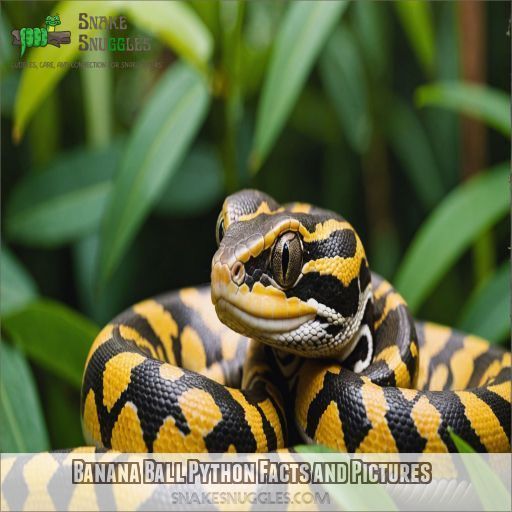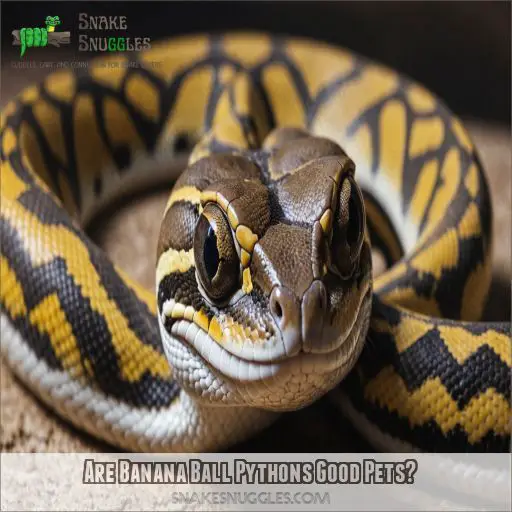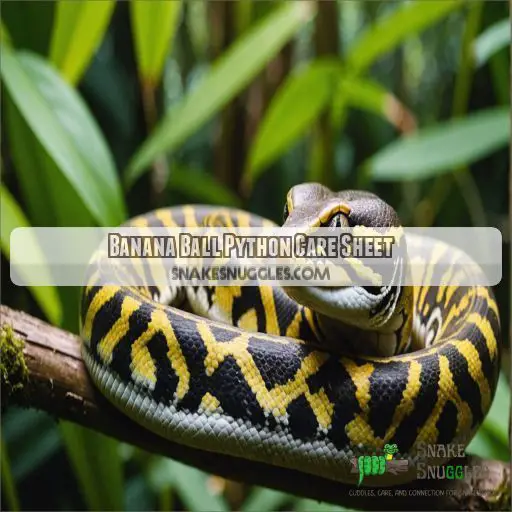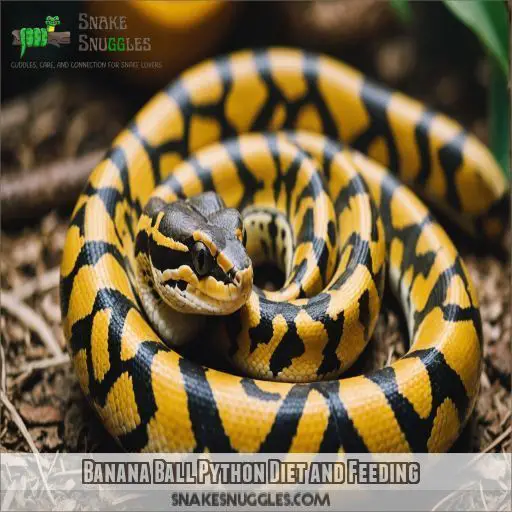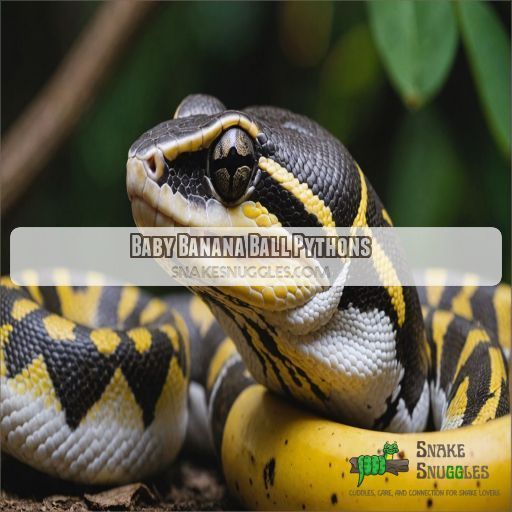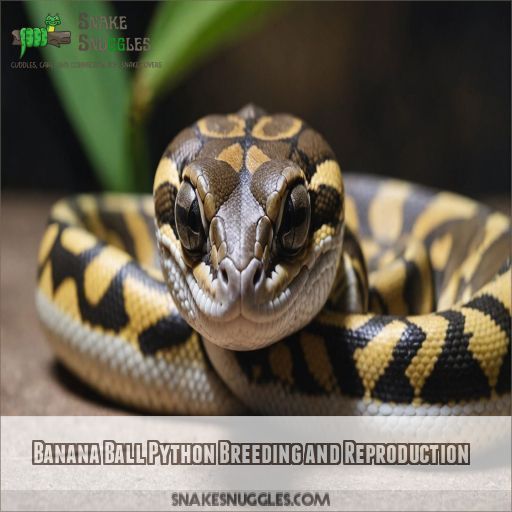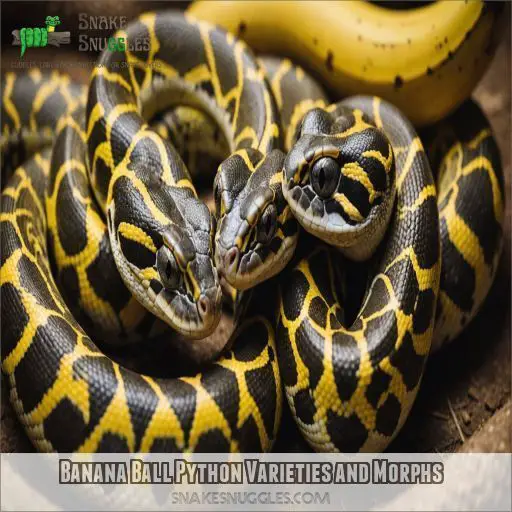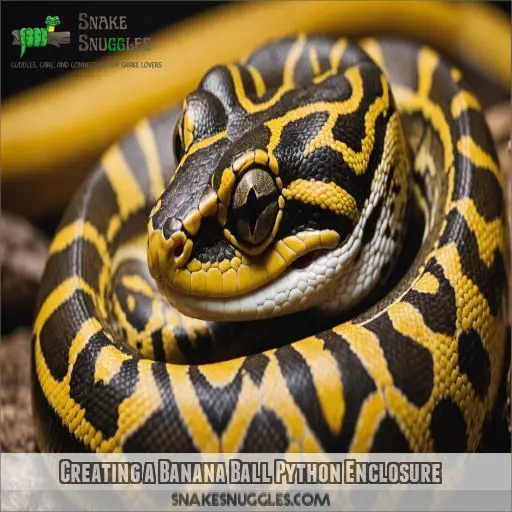This site is supported by our readers. We may earn a commission, at no cost to you, if you purchase through links.
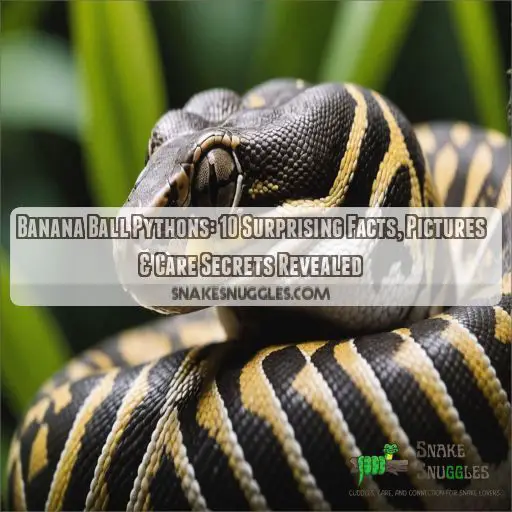 You’re about to enter the fascinating world of banana ball pythons!
You’re about to enter the fascinating world of banana ball pythons!
As a prospective owner, you’re likely interested to learn more about these stunning, non-venomous constrictors.
You’re in the right place – our complete guide is packed with amazing pictures and insightful facts to help you understand and care for your new pet.
From classification and conservation to care requirements and health issues, we’ve got you covered.
Get ready to discover the intriguing world of banana ball pythons, and by the end of this article, you’ll be a confident, snake-savvy owner, equipped with expert knowledge to give your pet the best life possible.
Table Of Contents
- Key Takeaways
- Banana Ball Python Facts and Pictures
- Are Banana Ball Pythons Good Pets?
- Banana Ball Python Care Sheet
- 6 Best Supplies for Banana Ball Pythons
- Banana Ball Python Diet and Feeding
- Baby Banana Ball Pythons
- Banana Ball Python Health Issues
- Banana Ball Python Breeding and Reproduction
- Banana Ball Python Varieties and Morphs
- Creating a Banana Ball Python Enclosure
- Frequently Asked Questions (FAQs)
- What are some interesting facts about banana ball pythons?
- Do banana ball pythons like to be held?
- Are banana ball pythons friendly?
- How often should a banana ball python eat?
- What is the ideal humidity level for banana ball pythons?
- Can banana ball pythons be housed together in pairs?
- How long do banana ball pythons typically live in captivity?
- What is the recommended temperature range for banana ball pythons?
- Are banana ball pythons prone to specific health issues?
- Conclusion
Key Takeaways
- You’ll want to choose a substrate that can handle moisture, such as soil mixes, coconut coir, or cypress mulch, and avoid pine or cedar shavings, which can cause respiratory issues in your banana ball python.
- To keep your banana ball python happy and healthy, you’ll need to provide a diet rich in rodents and other small prey items, fed at just the right frequency to support their growth and well-being—think every 5-7 days for hatchlings and every 10-14 days for adults.
- You’ll need to create a temperature gradient of 75-95°F, with a basking spot of 90-94°F, and allow for nighttime cooling to mimic the natural temperature drop, so your banana ball python can thrive in its enclosure.
- By mastering the art of handling and bonding with your banana ball python, you’ll be able to create a trusting relationship, where your snake feels secure and relaxed in your presence—just remember to think of yourself as a tree with branches, letting the snake curl around your arms, and avoid gripping or restraining it.
Banana Ball Python Facts and Pictures
You’re about to discover the fascinating world of banana ball pythons, with their striking yellow patterns and docile nature, making them a popular choice among snake enthusiasts . As you explore the unique characteristics, habits, and care requirements of these amazing creatures, you’ll learn why they’re an excellent pet for reptile lovers of all experience levels (Source).
Classification and Conservation
Let’s get up close and personal with the banana ball python’s taxonomic status. You’ll be relieved to know that these stunning serpents are classified as "Least Concern" on the conservation status scale. Here are 4 key takeaways:
- Kingdom: Animalia
- Phylum: Chordata
- Class: Reptilia
- Order: Squamata
Conservation efforts are in place to protect their habitats and prevent over-hunting.
Physical Characteristics
Let’s get up close and personal with your Banana Ball Python’s physical characteristics! You’ll notice their stunning yellow, tan, and orange hues, and how their glossy, smooth scales shimmer in the light. Their robust bodies boast a blunt nose and trapezoidal skull, with black patterns that beautifully border their yellow dots, making each ball python morph truly unique.
Habitat and Diet
Now that you know what makes your Banana Ball Python tick physically, let’s talk about what makes them thrive in their environment. Their African habitat requires a warm and humid climate, with plenty of hiding places and a burrowing substrate. A carnivorous diet means they need a variety of prey, and the right reptile supplies to keep them healthy.
- Prey items should be gut-loaded and varied, including rodents and birds
- A temperature control system is essential to maintain a comfortable environment
- A mix of dark and light hiding places helps reduce stress
- Fresh water and a balanced diet are key to maintaining nutritional balance
Behavior and Care
Now that you know what to feed your banana ball python, let’s talk about behavior and care. These snakes are non-venomous constrictors that are prone to hiding, so provide a cozy enclosure with hide boxes and a temperature gradient between 75-95F. Limit handling to a few times a week, as they tire easily and may spook quickly.
Interesting Facts
Let’s explore some interesting facts about banana ball pythons. Here are four fascinating tidbits:
- Long lifespan: Banana ball pythons can live up to 20-30 years in captivity, so be prepared for a long-term commitment.
- West African roots: These snakes originated in West Africa, where they inhabit savannas and grasslands.
- Rare morphs: The banana ball python is a rare morph of the ball python species, prized for its vibrant yellow color pattern.
- Unique characteristics: With their striking color patterns and docile nature, banana ball pythons have become a favorite among snake enthusiasts and breeders.
Are Banana Ball Pythons Good Pets?
You’re considering bringing a banana ball python into your life, and you’re wondering if they make good pets.
Well, you’re in luck because these gentle giants are known for their calm demeanor and are often a great choice for first-time snake owners.
With proper care and attention, a banana ball python can thrive and become a beloved and low-maintenance companion.
Temperament and Handling
In terms of temperament and handling, Banana Ball Pythons are a dream pet. They’re known for their calm nature and gentle disposition, making them perfect for first-time snake owners. With regular handling, they can become quite tame and enjoy human interaction.
| Handling Techniques | Snake Behavior | Taming Methods |
|---|---|---|
| Support their body | Initially, they may hide | Start with short sessions |
| Move slowly and calmly | As they relax, they’ll explore | Gradually increase handling time |
| Avoid gripping or constraining | With trust, they’ll curl up in your arms | Reward calm behavior with treats |
Care Requirements
Now that you know banana ball pythons are gentle giants, let’s talk care requirements. Providing a suitable enclosure is key. You’ll need a 15-20 gallon tank for hatchlings, 40 gallons for juveniles, and 120 gallons for adults. Don’t forget humidity control, temperature gradients, and a substrate that won’t cause respiratory issues. Your pet’s comfort is in your hands!
Health Issues
As a Banana Ball Python owner, being aware of potential health issues is vital. In the area of health issues, you’ll want to be on the lookout for signs of trouble. Here are 4 common health issues to watch out for:
- Mouth rot and scale rot
- Respiratory infections
- Skin infections
- Internal parasites – regular veterinary care can help prevent these issues.
Banana Ball Python Care Sheet
You’re ready to bring home your very own banana ball python – now it’s time to create the perfect environment for your new scaly friend! In this care sheet, we’ll walk you through the essentials of setting up a happy, healthy habitat, from tank size and temperature to substrate and decorations.
Tank Size
| Snake Size | Tank Length | Tank Width |
|---|---|---|
| Hatchling | 15-20 gallons | 12-18 inches |
| Juvenile | 30-40 gallons | 18-24 inches |
| Adult | 55-75 gallons | 24-36 inches |
| Breeding | 75-120 gallons | 36-48 inches |
| Large Adult | 120 gallons+ | 48 inches+ |
Humidity
Now that you’ve got your tank size sorted, let’s talk humidity! As a tropical species, banana ball pythons thrive in a humid environment, with an ideal range of 55-60%. Use a reliable hygrometer to monitor moisture levels, and consider a misting system to maintain the perfect balance. Don’t forget humidity hides to help your snake regulate its surroundings.
Lighting and Temperature
In terms of lighting and temperature for your banana ball python, you’ve got to get it just right. Here are the essentials:
- Basking spot options: heat lamps, ceramic heat emitters, or heat mats
- Temperature gradient control: aim for 75-95F with a thermostat
- Heat source types: avoid direct contact to prevent accidental burns
- Lighting cycle impact: simulate a natural circadian cycle
- Thermostat setting guidelines: research and invest in a reliable thermostat to prevent vision problems
Substrate
Now that you’ve got your temperature and lighting just right, it’s time to think about the substrate – the stuff that lines the bottom of your banana ball python’s enclosure. You’ll want to choose a substrate that can handle moisture, like soil mixes, coconut coir, or cypress mulch. Avoid pine or cedar shavings, as they can cause respiratory issues.
Decorations & Accessories
In terms of decorations and accessories for your banana ball python’s enclosure, you’ll want to create a West Africa-inspired environment that’s both stimulating and safe. Here are some essentials to get you started:
- Climbing structures, like rocks or branches, for exercise and basking
- Water features, such as a shallow dish or pool, for hydration and relaxation
- Hiding places, like logs or plants, for security and stress relief
- Temperature gauges to monitor the enclosure’s temperature
- Visual barriers, like plants or decorations, to block your snake’s line of sight and reduce stress
6 Best Supplies for Banana Ball Pythons
As you prepare to bring your banana ball python home, you’ll want to make sure you have the right supplies to create a comfortable and happy environment for your new pet. Here are the top six essential supplies you’ll need to get started, from the perfect terrarium tank to the best feeding tweezers, to guarantee your banana ball python thrives.
1. large reptile terrarium tank enclosure habitat
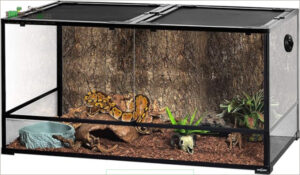
You’re setting up a home for your banana ball python – exciting times!
When choosing a large reptile terrarium tank enclosure habitat, you want a secure and comfortable space for your slithery friend.
Look for a tank that meets the following requirements:
- 120-gallon tank size for ample space
- Made of high-quality tempered glass for durability and safety
The tank’s features are important too. A front sliding door is essential for easy access. A waterproof raised bottom plate is a must for preventing any leaks or water damage. Larger-woven screen top ventilation provides adequate airflow and space for accessories.
Best For: This 120-gallon reptile terrarium is best for reptile enthusiasts who want a spacious and secure habitat for their pets, such as bearded dragons, tortoises, and ball pythons (Source).
- The terrarium is made of high-quality tempered glass, ensuring durability and safety for both the pet and the owner .
- The front sliding door provides easy access for maintenance and feeding, while the waterproof raised bottom plate prevents leaks and water damage (Source).
- The larger-woven screen top ventilation allows for adequate airflow and space for accessories, making it a great feature for reptile care .
- The terrarium may not be suitable for snakes that require specific temperature control, and the single cord access hole may be limiting .
- The tank may leak if not assembled correctly, and the lower water tank portion may not be deep enough for some users .
- The black back piece has a matte finish at the top but a shiny finish at the lower panel, which may cause reflection issues .
2. Reptile Heating Pad with Thermostat

When creating a comfortable home for your banana ball python, temperature control is key. A reptile heating pad with a thermostat is an essential item on your checklist.
Go for a pad with a reliable thermostat, like the 6 x 8 x 1 model, which reaches a toasty 104°F and comes with a handy digital display. This particular pad is a breeze to set up and ensures even heating throughout your snake’s habitat.
Remember these important safety tips:
- Secure the temperature probe
- Avoid placing any items on the pad
Best For: This reptile heating pad with thermostat is best for snake owners, particularly those with banana ball pythons, and individuals who need a reliable and easy-to-use heating solution for their reptile’s habitat .
- The adhesive works well, and the thermometer is easy to use, making it a convenient option for reptile owners .
- The heating pad provides even heating throughout the habitat, reaching a temperature of 104F, and comes with a handy digital display .
- The product is easy to install, heats up quickly, and provides accurate temperature readings, making it a good value for the price .
- Some users have reported issues with the thermostat LCD failing after a month, and the design makes it easy to accidentally press buttons and damage the screen .
- The adhesive may not be strong enough to hold the temperature probe in place, and some users have reported that the 3M adhesive is weak and may come off .
- The heat pad is small, which may not be suitable for larger enclosures, and may require additional tape to secure the temperature probe .
3. Fluker’s Reptile Heat Bulb 60 Watt

For a reliable heat source, consider Fluker’s 60 Watt Reptile Heat Bulb. However, I’ll introduce you to a similar product – the 60 Watt Ceramic Heat Emitter. This non-light emitting, infrared heat source is perfect for 24-hour use. Its large, circular design and compatibility with the Repta-Clamp Lamp make it an excellent choice. Users praise its heat output and durability, making it a great option for your banana ball python’s enclosure. Just guarantee proper installation for a safe and cozy habitat.
Best For: The Fluker’s 60 Watt Ceramic Heat Emitter is best for reptile and amphibian owners seeking a safe and reliable heat source for their pets’ enclosures.
- Provides natural, infrared heat without bright light.
- Offers 24-hour use for consistent temperature regulation.
- Durable and long-lasting, according to user reviews.
- The bulb can get hot, but not unbearably so.
- Requires a compatible Repta-Clamp Lamp for installation.
- Limited information on the specific heat output and temperature range.
4. Reptile Mister Fogger System

You’re setting up a terrarium for your banana ball python, and you know how important maintaining the right humidity is. That’s where the Reptile Mister Fogger System comes in – a game-changer for creating a tropical environment. With its 360-degree spray nozzle, timed spray function, and internal backwatering technology, this system helps your pet stay comfortable and healthy. Plus, its 2.6-gallon water tank means less frequent refills, giving you more time to enjoy your slithery friend.
Best For: Reptile owners who want to create a humid environment for their pets, especially those with larger terrariums or multiple cages.
- The system has a large 2.6-gallon water tank, allowing for less frequent refills and a more consistent humid environment .
- The 360-degree spray nozzle and timed spray function provide a customizable and naturalistic misting experience for reptiles .
- The system is easy to use, with simple dials that allow for complete control over the frequency, duration, and power of the spray .
- Some users have reported difficulty sticking the nozzles to their vivarium, and a few have experienced small leaks from the nozzles .
- The unit can be relatively loud, similar to an electric toothbrush, and the spray emitters cannot be fully reduced, resulting in a large amount of water being dispensed .
- A few users have reported issues with the timer function, requiring them to manually turn the cycle dial to a number, let it spray, and then turn the dial back to zero .
5. Natural Sphagnum Moss for Terrariums
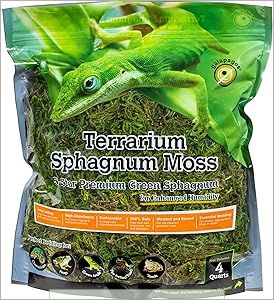
In terms of creating a cozy habitat for your banana ball python, Natural Sphagnum Moss for Terrariums is a game-changer. This long-lasting, leafy green moss enhances humidity and shedding, making it perfect for tropical and wetland terrariums. With its natural, elegant appearance, it’s a great choice for reptile enthusiasts. Just remember to clean and ventilate regularly to prevent mold. Your snake will thank you for this comfy, non-toxic substrate that’s sustainably sourced and easy to use.
Best For: Reptile enthusiasts and owners of tropical and temperate species, such as geckos, lizards, frogs, snakes, and banana ball pythons .
- Long-lasting, long-fiber leafy green sphagnum moss that enhances humidity and shedding, making it perfect for tropical and wetland terrariums .
- Natural and elegant appearance, sustainably sourced, and non-toxic, making it a great choice for reptile enthusiasts .
- Can be used for decorative purposes, such as florals and gardens, and is available in other types of moss .
- May require regular cleaning and good ventilation to prevent mold .
- May not be suitable for all types of reptiles or amphibians, so owners should research the specific needs of their pets before using .
- Can be more expensive than other substrate options, especially for larger terrariums .
6. Stainless Steel Reptile Feeding Tweezers

If you’re feeding your banana ball python, you’ll want a trusty pair of stainless steel reptile feeding tweezers. Look for a pair made from medical-grade stainless steel that’s sturdy and resistant to corrosion. A no-slip tip helps you get a good grip on prey, while the smooth curved edge reduces damage to your pet. Plus, they’re easy to clean and can be used for a variety of tasks, from aquascaping to kitchen use.
Best For: These tweezers are best for reptile owners who need a safe and reliable way to feed their pets.
- Made from durable, corrosion-resistant stainless steel
- Feature no-slip tips for a secure grip on prey
- Easy to clean and versatile for multiple uses
- May be too long for smaller reptiles
- The smooth curved edge may not be ideal for all prey types
- The serrated grip tip could potentially damage delicate prey items
Banana Ball Python Diet and Feeding
You’re about to become an expert on feeding your Banana Ball Python – and trust me, it’s easier than you think! To keep your pet snake happy and healthy, you’ll need to provide a diet rich in rodents and other small prey items, fed at just the right frequency to support their growth and well-being.
Prey Items
For prey items for your banana ball python, think small to medium-sized rodents. Pinkie rats are a staple for hatchlings, while adults enjoy a varied diet of fuzzy mice and hopper rats. Choose prey with high nutritional value from reputable breeders to mimic their wild diet. Research the ideal prey size for your snake’s age and size.
Feeding Frequency
Let’s talk feeding frequency! As a Banana Ball Python owner, you’ll want to know how often to feed your slithery friend. Hatchlings need food every 5-7 days, while adults can eat every 10-14 days. Don’t worry if they skip meals; healthy Ball Pythons can go up to six months without eating. Establish a schedule and stick to it!
Hatchling Diet
Now that you’ve got a handle on feeding frequency, let’s talk about what to feed those adorable hatchlings! For their first meal, offer a pinkie rat (about 1-2 grams). As they grow, you can gradually increase prey size. Here are some guidelines:
- First feeding: Pinkie rat (1-2 grams)
- First week: Feed every 5-7 days
- Nutrition needs: No supplements needed, just a balanced rodent diet
Baby Banana Ball Pythons
As you welcome a baby ball python into your family, get ready for a thrilling adventure of discovery and growth – both yours and your pet’s!
You’ll be embarking on a journey of learning and bonding with your new scaly companion.
This section will guide you through the essential aspects of caring for your tiny, scaly friend, covering size and growth, care and handling, and feeding and nutrition to make sure you’re well-prepared for the fun times ahead.
Size and Growth
As you welcome your baby banana ball python, you’re probably wondering how big it’ll get. Hatchlings start at about 10 inches, but don’t worry, they’ll grow – females up to 5 feet and males around 3 feet. You’ll notice a significant growth spurt in the first year, with a slower rate after that. Sexual dimorphism is quite pronounced in this species!
Care and Handling
When it comes to baby banana ball pythons, care and handling are a delicate dance.
You want to provide a secure enclosure setup that fosters growth.
But also handle them gently to prevent stress.
Look for signs like tongue-flicking or coiling, which indicate they’re feeling anxious.
Handle them briefly, 2-3 times a week, to meet their socialization needs and help them become confident, calm snakes.
Feeding and Nutrition
Feeding your baby banana ball python is a breeze. Offer prey items like pinkie rats or fuzzy mice, gut-loaded with nutritious foods.
A calcium supplement can support their growth.
Feed every 5-7 days, and make sure fresh water is always available.
As they grow, adjust the prey size and feeding schedule accordingly.
A happy, well-fed snake is a joy to behold.
Banana Ball Python Health Issues
You’re probably wondering what health issues to watch out for in your banana ball python.
After all, these lovable snakes can live up to 30 years, and you want to make sure they stay healthy and happy.
Let’s explore the common health issues that can affect banana ball pythons, as well as the signs of a healthy snake and some valuable tips on handling and bonding.
Common Health Issues
Now that you’ve fallen in love with those adorable baby banana ball pythons, it’s time to get real about the not-so-cute stuff: common health issues. Keep an eye out for mite infestations, respiratory problems, scale rot, and parasite control. Regularly inspect your snake’s mouth for signs of infection, and don’t hesitate to consult a vet if you notice anything off.
Signs of a Healthy Snake
To gauge your Banana Ball Python’s health, look for these key indicators. A healthy snake sheds its skin in one piece, doesn’t lose weight, and has a good balance. It should use both warm and cool sides of the enclosure and breathe silently. Also, check for light-colored belly scales. Monitor these signs to verify your pet is thriving.
Handling and Bonding
When handling your banana ball python, think of yourself as a tree, with your arms as branches. Support their body, and let them curl around you. Here are some handling and bonding tips:
- Move slowly and calmly to avoid stressing your snake
- Handle your snake gently, but firmly
- Start with short sessions, and gradually increase time
- Be patient, and let your snake come to you
- Reward calm behavior with treats, like a tasty rat snack
Banana Ball Python Breeding and Reproduction
You’re ready to take your Banana Ball Python parenting to the next level by learning about breeding and reproduction. In this section, you’ll discover the essential requirements for successful breeding, the fascinating process of female egg-laying, and the critical care needed for those adorable hatchlings.
Breeding Requirements
Breeding banana ball pythons can be a thrilling experience, but it requires careful planning. To set yourself up for success, focus on Breeding Stock Selection, choosing healthy, genetically diverse parents. Consider Environmental Triggers, like temperature and humidity, to stimulate breeding. Then, master Mating Techniques and Incubation Methods to promote a healthy clutch.
| Breeding Requirement | Description | Tips and Tricks |
|---|---|---|
| Breeding Stock Selection | Choose healthy, genetically diverse parents | Research, select from reputable breeders |
| Environmental Triggers | Temperature, humidity, and lighting | Simulate natural environments, experiment with triggers |
| Mating Techniques | Pair snakes, monitor behavior | Watch for courtship behaviors, separate if necessary |
| Incubation Methods | Temperature, humidity, and turning | Invest in a reliable incubator, monitor eggs closely |
Female Banana Ball Python Egg-Laying
Female Banana Ball Pythons are quite the busybodies when it comes to egg-laying. Here’s what you need to know about their reproductive prowess:
- Egg Incubation Period: The female will wrap herself around her clutch of eggs until they hatch, which usually takes around 50 to 60 days.
- Female Fertility Issues: It’s important to make sure the female is of adequate size before breeding. Insufficient weight can lead to severe health issues, such as becoming egg-bound.
- Egg-Laying Frequency: Females can lay multiple clutches of eggs in a breeding season, but this varies. A clutch can range from one to twelve eggs, and the eggs will adhere to each other for a few days before hatching.
- Breeding Age Factors: Females typically reach sexual maturity between 27 to 31 months of age and should be at least 1200 grams before breeding.
- Clutch Size Variations: A female’s clutch size can differ due to factors like age, health, and environmental conditions. On average, a female Banana Ball Python lays around six eggs per clutch.
Hatchling Care
So, you’ve welcomed a baby ball python into your home, and now it’s time to make sure their well-being and comfort. Here’s a guide to help you understand the early days and weeks of caring for your new scaly friend.
Hatchlings should be kept in a 15-20 gallon tank with a cozy hide spot. Provide ample substrate for burrowing and mimic their natural habitat with decorations like plants, rocks, and logs.
Maintain a basking spot between 88-96F and an ambient temperature of 78-80F. The ideal humidity is 55-60%, with a slight increase for hatchlings. Use a hydrometer to monitor humidity levels.
Hatchlings should be fed pinkie rats after their first shed, approximately every 5-7 days. Avoid handling your python for 12 hours after feeding, and always use feeding tongs to prevent accidental bites.
Establish trust with your hatchling through regular, gentle handling. Allow them to explore calmly, avoiding sudden movements. Always supervise children during handling, and ensure their safety and that of your python.
Keep an eye out for signs of shedding, such as opaque skin and milky blue eyes. Ensure proper humidity to facilitate smooth shedding. If your python is having trouble shedding, increase the humidity and provide ample water for soaking.
Banana Ball Python Varieties and Morphs
As you explore the fascinating world of banana ball pythons, you’ll discover a stunning array of varieties and morphs, each with its unique genetic expression, color patterns, and size variations. From the vibrant yellows and oranges to the intricate patterns and markings, you’ll be amazed at the diversity within this popular pet snake species.
Genetic Expression
You’re ready to understand the secrets of your banana ball python’s stunning appearance. Their unique genetic expression is what sets them apart. Here’s a brief rundown of the genetic magic at play:
- Morphs: The result of combining recessive and dominant genes.
- Recessive genes: Influence traits like color and pattern.
- Dominant genes: Control traits like size and texture.
- Genetic variation: Creates an incredible range of banana ball python varieties.
Color Patterns
Your Banana Ball Python’s color pattern is a unique work of art! The interaction of genetics and environment creates stunning variations. Let’s break down the color palette:
| Morph Type | Pattern | Color |
|---|---|---|
| Banana | Yellow blotches | Creamy white |
| Super Banana | Vibrant yellow | Darker yellow |
| Pastel Banana | Soft, pale yellow | Pale orange |
| Ghost Banana | Faded yellow | Smoky gray |
| Piebald Banana | White with yellow patches | Irregular patches |
Each morph type showcases the incredible diversity of Banana Ball Python color patterns, making every snake a one-of-a-kind treasure!
Size Variation
Regarding size variation, Banana Ball Pythons exhibit some fascinating differences. Female Banana Ball Pythons can grow up to 5 feet in length, while males typically reach 3 feet. Hatchlings start at around 10 inches, and their growth rate is relatively steady. Just remember, every snake is unique, so be prepared for some individual variation!
Creating a Banana Ball Python Enclosure
As you get ready to bring your new banana ball python home, it’s time to create a comfortable and safe enclosure that’ll make your pet thrive. In this section, you’ll learn how to set up the perfect environment, including temperature and lighting requirements, humidity and substrate options, and decorations and accessories to keep your snake happy and healthy.
Temperature and Lighting Requirements
Creating a cozy home for your banana ball python? Let’s talk about temperature and lighting requirements. Here are three essentials to get right:
- Use a heat lamp or ceramic heat emitters to maintain a temperature gradient of 75-95F, with a basking spot of 90-94F.
- Provide a UVB light source to simulate natural daylight.
- Allow for nighttime cooling to mimic the natural temperature drop.
Humidity and Substrate
Now that you’ve got the temperature right, it’s time to focus on humidity and substrate.
Ball pythons require humidity levels of 50% to 60% to stay healthy. You can control humidity by using a water bowl, misting the enclosure, and choosing the right substrate.
Use a hygrometer to monitor humidity levels. If they drop too low, your snake may have trouble shedding, and if they’re too high, bacteria and fungi can thrive, leading to infections.
For substrate, you’ve got options. You can go with soil mixes, coconut coir, cypress mulch, or paper towels. Just make sure to avoid pine or cedar shavings, as these can be harmful to your snake.
Provide a substrate layer that’s at least 2-4" deep. While ball pythons don’t dig into their substrate, a deeper layer helps maintain the humidity they need.
The ideal humidity for your enclosure is 50-60%. You can achieve this by using a combination of a water bowl, misting, and the right substrate.
The right substrate is key to maintaining the right humidity levels and preventing health issues like scale rot. It also provides a natural environment for your snake to burrow and hide.
Decorations and Accessories
Now that you’ve got your humidity and substrate sorted, it’s time to decorate! Think of your banana ball python’s enclosure as a spa retreat. You’ll want to add some enrichment to keep them engaged. Here are some ideas:
- Add hiding spots like logs, rocks, or plants to help them feel secure
- Incorporate climbing structures to encourage exercise
- Use shallow water bowls for a relaxing soak
Frequently Asked Questions (FAQs)
What are some interesting facts about banana ball pythons?
Imagine having a pet that’s as cool as it’s cute! Banana ball pythons are a treasure trove of fascinating facts – from their vibrant yellow patterns to their ability to go six months without eating.
Do banana ball pythons like to be held?
When you hold your banana ball python, remember to think of yourself as a tree with branches – let the snake curl around your arms, avoiding gripping or restraining it .
Are banana ball pythons friendly?
A friend in need is a friend indeed." And that’s exactly what you’ll get with a Banana Ball Python.
Known for their docile nature, these snakes are friendly and suitable for all experience levels.
They may be shy and take time to adapt, but they can become lovable pets.
Just remember, they spook easily, so approach them slowly and avoid sudden movements.
How often should a banana ball python eat?
You’ll want to feed your banana ball python every 5-7 days when they’re hatchlings, and every 10-14 days as adults. Don’t worry if they skip meals, as healthy captives can go up to six months without eating!
What is the ideal humidity level for banana ball pythons?
You want to get the humidity just right for your scaly friend! Aim for 55-60% humidity, and bump it up a notch for hatchlings. This will keep your banana ball python happy, healthy, and hydrated.
Can banana ball pythons be housed together in pairs?
Imagine introducing two banana ball pythons, Luna and Leo, to the same enclosure – a recipe for disaster! Unfortunately, banana ball pythons are best kept alone, as they’re not sociable and may fight or stress each other out.
How long do banana ball pythons typically live in captivity?
You can expect your banana ball python to live a pretty long life – typically between 20 to 30 years in captivity, with some individuals reportedly living up to 40 years or more with proper care .
What is the recommended temperature range for banana ball pythons?
You’ll want to keep your banana ball python’s warm side between 84-89F, the basking surface at 90-94F, and the cool side at 75-80F . This temperature range will help your pet stay happy and healthy.
Are banana ball pythons prone to specific health issues?
You’ll want to keep an eye out for common health issues in your banana ball python, such as snake mites, mouth rot, scale rot, respiratory infections, and internal parasites .
Conclusion
Now that you have the inside scoop, you’re ready to "snake" your way into banana ball pythons!
With this complete guide, you’ve learned the essential care requirements, surprising facts, and expert secrets to give your pet the best life possible.
As a snake-savvy owner, you’ll be well-equipped to handle any situation that comes your way.

